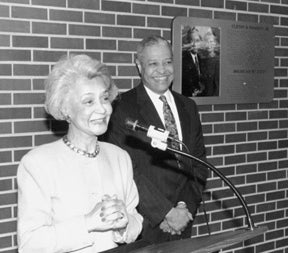
A Lasting Legacy: Dr. Clifton R. Wharton Jr.
Dr. Clifton R. Wharton Jr. was the 14th president of Michigan State University and the first Black president of a major U.S. public research university. His eight-year presidency began in 1970, but the impacts of his leadership and legacy still live on today.
When Dr. Wharton and his wife Dolores arrived in East Lansing, they brought with them a love and deep appreciation of the arts. Since 1939, the MSU Auditorium was the primary performance venue on campus, and even then, was considered outdated. The MSU Auditorium was originally constructed as a multi-use facility, hosting a range of events from college dances to the Farmers’ Week convention. While useful, this made it slightly less competitive to renowned artists MSU wished to bring to the Mid-Michigan area.
“We felt very strongly—Dolores in particular—that we needed to have a new facility,” Dr. Wharton said in a 2009 interview with MSU Today.
Their inspiration and vision moved Dr. Wharton to hire the university’s first development officer and launch MSU’s first major capital campaign, a component of which was devoted to the creation of a performing arts center. The success of the campaign with students, faculty, and administrator organizations led to over $1 million dollars raised.
While Dr. Wharton left the university in 1978, his vision for the arts lived on. The ground was broken for the performing arts center in 1980, with roughly half of the funds for the project secured.
During its construction, which took over two years, the MSU Board of Trustees voted to name the center the Clifton and Dolores Wharton Center for Performing Arts.
“Dolores and I were deeply touched by the board’s action,” Dr. Wharton wrote in his book, Privilege and Prejudice: The Life of a Black Pioneer. “We loved Michigan State and the performing arts. Now, the two strands of our affection were permanently entwined, and the university would have a cultural showcase that could stand proudly with its other centers of excellence.”
At long last, on September 25, 1982, the Chicago Symphony Orchestra and soprano Birgit Nilsson performed on the stage, ushering in a new arts era for the university.
During the 42 years since Wharton Center’s official opening, Wharton Center has held true to the Wharton’s vision that art and creativity play a vital role in academic excellence and community. Through the embodiment of this belief, Dr. Wharton’s legacy will live on.
